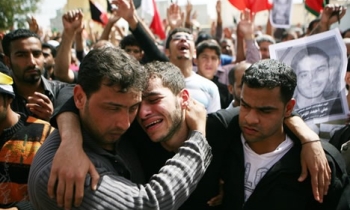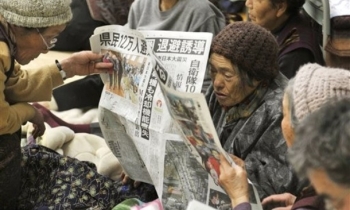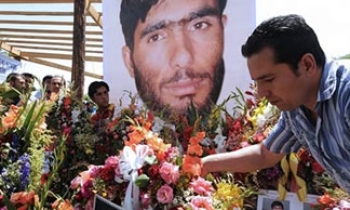Here is a media & health paradox: despite low levels of literacy among the populations most at risk of contracting HIV/AIDS, a recent study has found greater coverage of HIV/AIDS stories in print media rather than in broadcast media. Of the 356 stories sampled over two-week monitoring periods, 281 (79 per cent) were from the print media and 75 (21 per cent) from the broadcast media. While more print media was monitored than broadcast proportionally, broadcast media generally had a lower incidence and proportion of reports on HIV/AIDS.

These findings are from a study conducted by the International Federation of Journalists (IFJ) which focused on six countries across Africa and Asia. The report was released at an IFJ Africa-Asia cross-regional meeting on reporting HIV/AIDS, on July 25-26, 2006 in Phnom Penh, Cambodia. The meeting – A Story A Day: The Media and Reporting HIV/AIDS – was hosted by the IFJ affiliate in Cambodia, the Cambodian Association for the Protection of Journalists (CAPJ).
The research, including media monitoring which examined 356 articles that mentioned HIV/AIDS over the two-week monitoring periods in Africa and Asia, uncovered sensational reportage and terminology such as 'deadly disease', 'HIV holocaust', 'scourge' and 'deepest wound in society'.
The research, supported by the Swedish trade union movement, the LO-TCO, focused on the Philippines, India, Cambodia, Zambia, South Africa and Nigeria. There were two parts to the research: media monitoring for two two-week periods (one for Asia and one for Africa) in late November/December 2005 to determine the quality and quantity of HIV/AIDS reports in the media; and surveys of journalists and NGOs in the HIV/AIDS field on their perception of coverage of HIV/AIDS.
Media monitoring found a low incidence of HIV/AIDS stories across most media in the six countries. Researchers variously described the incidence of HIV stories during the media monitoring as "small" (Cambodia and the Philippines), "miniscule" (South Africa), and "infrequent" (India). In Nigeria, the researcher noted that cartoonists in particular had "gone to sleep on HIV/AIDS". When they appeared in Asian media, HIV stories were generally given a moderate to high prominence, although researchers in all three Asian countries felt this was related to World AIDS Day (which occurred during the monitoring period in Asia). Researchers in African countries found that prominence varied and that many stories were event-based and buried. All researchers reported that, overall, the number of HIV/AIDS stories in print and broadcast media was low compared to other stories during the two monitoring periods.

In Zambia and Nigeria especially, television coverage was extremely low, a particular problem given the low literacy rates in these countries. In Zambia, the research found that HIV/AIDS stories accounted for only 20.5 minutes of the 700 news minutes (just under 3 per cent) broadcast on television and radio combined over the two week monitoring period. Similarly, in Cambodia, even including World AIDS Day, stories that mentioned or featured HIV/AIDS accounted for less than 3 per cent of all the total news stories of the outlets monitored.
The research found a distinct disjunct between the monitored level of reportage and journalists' perceptions of the level of reportage, and also between journalists' perceptions and NGOs' perceptions. For example, despite negligible levels of reporting of HIV in the monitored media during the monitoring period in South Africa, journalists perceptions from the survey was that reporting of HIV and AIDS was frequent and regular: 60 per cent said coverage of HIV was 'moderate', while 30 per cent said it was 'high'.
Almost 60 per cent of journalists surveyed in both India and Zambia said they filed one to five HIV/AIDS stories weekly; however while Zambian journalists thought their stories appeared quite frequently (55 per cent), 20 per cent in India said they had difficulty getting published. Journalists in Cambodia said they filed one to five stories about HIV/AIDS monthly and that their news organisations published a story a week or more on the topic. Journalists in the Philippines were disappointed that only a few media organisations covered the topic every week, while 65 per cent of Zambian journalists thought that their media outlets published six or more HIV/AIDS stories per week. In all three Asian countries, journalists thought HIV/AIDS had a moderate to high news value.
Although the media monitoring exercise found reporting to be of good quality, a significant proportion of journalists and NGO respondents in all countries surveyed thought reporting was imbalanced and contributed to negative stereotyping. Almost all countries reported a perceived improvement in reporting over the last five years. Articles were generally seen as balanced and sensitive. Images used in stories, in particular, were seen to be sensational and in the Philippines, NGOs thought that journalists usually downplayed the crisis. Similarly, in South Africa the use of images was seen to be problematic. The issue of identification of people living with HIV/AIDS (PLWHA) was difficult and varied from country to country: in the Philippines, there is a law that prohibits journalists identifying PLWHA while in India, the media regularly identified those living with HIV.

Language and tone were generally seen as positive. However there were regular reports of misleading, and derogatory language used in media, including "AIDS sufferers", "AIDS patient", AIDS "scare" along with several dubious and misleading reports including that garlic can be a cure for HIV (it is not) and that HIV-positive people are more prone to car accidents (they are not). Censorship, whether external or internal, was perceived to be a factor in HIV/AIDS reportage. However, the perceived source of any censorship differed according to the country and whether the respondent was a journalist or an NGO staffer.
The Zambian research indicated a feeling of 'story fatigue' among some editors and journalists about HIV/AIDS. In South Africa, startlingly, a significant minority of 10 per cent of journalist respondents said HIV/AIDS had 'low' news value, while 80 per cent said they filed no HIV stories over the last month. In Asia, a different issue arose: that of the story of HIV being connected to the 'taboo' issues of sex and homosexuality. This was noted as a particular problem in India.
In India, 58 per cent of NGO respondents were satisfied with the coverage, but felt it had a medium to low prominence and was infrequent. NGO staff in Cambodia felt coverage was poor or only satisfactory while staff at Filipino NGOs thought coverage was poor in general. Less than one-third of NGOs in Zambia thought that story placement, story prominence or story frequency was high. The story was very different in South Africa, where 70 per cent of NGO respondents were satisfied with general coverage and the vast majority (more than 90 per cent) thought story placement, prominence and frequency were medium/acceptable. On the whole, NGOs felt that coverage of HIV/AIDS had improved in the last five years, particularly in India and South Africa
A majority of journalists and NGO respondents in all countries surveyed agreed that training in HIV/AIDS reporting would improve coverage. While very few journalists had received training, most journalists in India and Cambodia believed they were either very informed or quite informed about HIV/AIDS. The most striking contrast was in South Africa, where only 6 per cent had received training and yet 97 per cent felt they were very informed. Zambia stood out as having had the most training and, not surprisingly, the highest number of journalists who felt they were very well informed. However, all showed less confidence in specific topics such as medical breakthroughs, people living with HIV/AIDS (PLWHA), treatments for HIV/AIDS, and HIV/AIDS orphans. This contrasted sharply with the Philippines, where 88 per cent of journalists said they wanted access to more information on a wide range of topics.

The least covered topics were HIV/AIDS orphans and medical breakthroughs in HIV/AIDS research. In India and Cambodia, journalists said topics most covered were the transmission of HIV, followed by the treatments available for HIV/AIDS and deaths from HIV/AIDS. In the Philippines, the most covered topic was deaths from AIDS followed by PLWHA and transmission of the virus. In Zambia, coverage of the topic seemed to have moved away from HIV and AIDS altogether and on to the mileage to be gained from being seen to do something about the crisis.
More than half (56 per cent) of stories in Zambia concerned ceremonies, donations and government and NGO announcements. In Nigeria, the opposite was true: almost all stories that appeared during monitoring were health stories, although those that did appear elsewhere were similarly event-based 'soft news' rather than issue-based economic or political stories. NGOs in India said only the transmission of HIV/AIDS received moderate coverage, while all other topics on HIV/AIDS had low coverage and were split on whether media provided adequate information on resources for PLWHA. In the Philippines, NGO staff felt the media did not provide enough information of this kind.
Journalists in all three Asian surveys nominated health officials then NGOs as the most popular sources for their stories on HIV/AIDS. In Africa, however, health officials and PLWHA were equally important. However, 50 per cent of journalists in India, for example, thought information from government sources was biased or limited. Journalists in the Philippines felt that information from both government officials and NGOs was limited. NGOs in Cambodia thought journalists have difficulty getting information from them, citing a number of barriers. They also complained about journalists asking for money in exchange for publishing stories. Journalists in Africa rated information from NGOs as very good or excellent (Zambia) or overwhelmingly satisfactory (86 per cent, South Africa).

In Asia, PLWHA were generally not sources for stories about HIV/AIDS. In the Philippines, while reporting was perceived as generally supportive of PLWHAs, people who actually had HIV were one of the least likely sources for journalists on HIV and AIDS. In India, there was a perception that the media was fair and gave a 'voice' to PLWHAs, but again, the monitoring showed they were one of the least likely sources to be used in a media report. This contrasted markedly with some of the African research, which showed that PLWHAs were more likely to be used as sources.
Across all countries surveyed, journalists and NGOs expressed an interest in a network for HIV/AIDS reporting. However, the preferred method and timing differed markedly between countries and journalists/NGOs. In particular, Cambodian journalists reported that they had little Internet access or knowledge. Journalists in Nigeria have an existing network to combat AIDS and produce material on HIV/AIDS reporting, but the website has not been updated significantly since 2000.
The IFJ report has made the following recommendations for media establishments:
- Increase the quality, quantity and diversity of news reports on HIV/AIDS broadcast and published, particularly in the broadcast media.
- Institute wide-ranging, regular and sustained training program for journalists and editors on HIV/AIDS issues, ranging from prevention to transmission and treatment, appropriate use of language and images, and issues surrounding identification and giving a 'voice' to people living with HIV/AIDS.
- Develop and implement editorial guidelines and policies for coverage of public health issues and gender issues, particularly HIV/AIDS, with specific references to the issue of confidentiality for people living with HIV or AIDS.
- Develop sustained and comprehensive media strategies to address the HIV/AIDS pandemic.
- Produce HIV/AIDS materials and resources on improving reporting of HIV/AIDS in local languages.
- Encourage all levels of editorial staff to form a strong partnership with health professionals, members of civil society, communities and others to enable them to diversify their sources of information and to give HIV/AIDS coverage a more human-centred approach.
- Adopt policies on HIV/AIDS in the workplace and engage with journalists on the importance of safe behaviour to limit the risk of HIV infection.
- Adopt the International Labour Organization's Code of Practice on HIV/AIDS.









